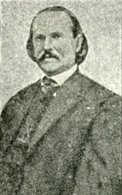Eli Metcalfe Bruce
Eli Metcalfe Bruce (born February 22, 1828 in Flemingsburg , Kentucky , † December 15, 1866 ) was an American philanthropist and politician .
Career
Eli Metcalfe Bruce, son of Sabina Metcalfe and George S. Bruce, was born in Fleming County . He attended the local schools until 1847. His youth was overshadowed by the economic crisis of 1837 and the Mexican-American War in the following years . He began in a dry goods store in 1847 Maysville ( Mason County to work). Shortly after, he moved to Northern Kentucky, where he worked in the pig slaughterhouse his uncle from Cincinnati ( Ohio began to work). Bruce married Elizabeth Sally Withers in 1853. The couple had three children together. In 1854 he and his uncle opened an iron foundry near Terre Haute ( Indiana ). In 1859 he sold his stake in the iron foundry and acquired several pig slaughterhouses along the Mississippi River , the Missouri River and the Wabash River . These ventures made Bruce a wealthy young man.
Shortly before the outbreak of the Civil War , Bruce sold all of his businesses in the north and moved south . In November 1861, he took part as a delegate to the Secession Assembly in Russellville, Kentucky, where he was elected to the Legislative Council of the Shadow Confederate Government. When Kentucky was admitted to the Confederation in December 1861 , Bruce was elected as one of twelve delegates first to the first and then to the second Confederate Congress , where he served until the end of the Confederation.
He funded much of the supplies for the Kentucky Orphan Brigade himself . His negotiations on an exchange of prisoners for this unit led him to be asked to conduct such negotiations for the entire Confederate States.
Shortly before the end of the war Bruce fled to the Confederate President Jefferson Davis (1808-1889) to Richmond ( Virginia ). Bruce was later captured in Georgia but released when the war ended. He then founded a office in Augusta ( Richmond County to help with the return home) with the intention of Confederate soldiers. On May 10, 1865, he published an open letter offering to pay the training costs of a Confederate soldier who had lost an arm or a leg in the war. It is estimated that Bruce contributed about $ 400,000 to relieve the Confederate soldiers. He was pardoned by President Andrew Johnson (1808–1875) of any crime in support of the southern states.
Bruce funded the merger of two Louisville, Kentucky newspapers - The Courier and The Journal - to form The Courier-Journal. He later moved to New York City , where he became a cotton broker and opened a hotel for the use of former Confederate soldiers. His wise investments made him grow his fortune. In this regard, shortly after the war, he invested in an abandoned gold mine in South Carolina , where he found a new vein of gold.
Bruce died on December 15, 1866 of complications from heart disease and was then buried in Linden Grove Cemetery in Covington, Kentucky. His remains were exhumed in 1917 and laid to rest near his wife and daughter at Highland Cemetery in Fort Mitchell, Kentucky.
Honors
The Northern Kentucky Association of the Sons of Confederate Veterans was named after him.
literature
- University of Pennsylvania and Department of Law: The American Law Register, Volume 4, DB Canfield, 1865, p. 96.
Individual evidence
- ↑ a b c d e f g h Guide to the Bruce Family Papers, Northern Kentucky University .
- ↑ Wednesday, November 20, 1861 ( Memento of the original from September 30, 2007 in the Internet Archive ) Info: The archive link has been inserted automatically and has not yet been checked. Please check the original and archive link according to the instructions and then remove this notice. , Civil War Landscapes Association
- ↑ The Confederate States Almanac and Repository of Useful Knowledge: For the Year 1863, Gale Cengage Learning, ISBN 9781432804930 , pp. 33 f.
- ^ Edwin Anderson Alderman and Southern Men of Letters: Library of Southern Literature, Part 15, Kessinger Publishing, 2005, ISBN 9781417933198 , p. 58.
Web links
| personal data | |
|---|---|
| SURNAME | Bruce, Eli Metcalfe |
| BRIEF DESCRIPTION | American philanthropist and politician |
| DATE OF BIRTH | February 22, 1828 |
| PLACE OF BIRTH | near Flemingsburg , Kentucky |
| DATE OF DEATH | December 15, 1866 |
